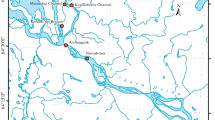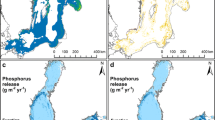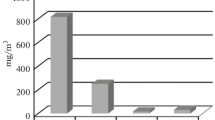Abstract
The changes in the concentrations of the mineral nitrogen (nitrates and nitrites) and phosphorus and in the state of the planktic communities in the eastern Gulf of Finland following a large-scale invasion of the polychaete Marenzelleria arctia were analyzed. The bioirrigation and bioturbation of the bottom deposits by polychaetes resulted in a dramatic increase in the nitrogen/phosphorus ratio in the waters of the gulf, thus leading to cascade changes in the plankton. As a result of the decrease in the abundance of colonial nitrogen-fixing cyanobacteria, which cause “blooming” in surface waters, the total biomass of the phytoplankton and chlorophyll a concentration decreased. Because of the disappearance of large colonies of cyanobacteria and the surge of small algae, the food supply for the zooplankton improved and its biomass increased. According to our calculations, the amount of phosphorus deposited in the bottom sediments as a result of the polychaete activity markedly exceeded the external phosphorus load on the Gulf of Finland from the Russian coast. We conclude that the invasion of Marenzelleria arctia resulted in the cardinal reconstruction of the entire ecosystem of the eastern Gulf of Finland.
Similar content being viewed by others
References
S. V. Aleksandrov, Primary Production of Plankton in the Baltic Lagoons (Vislinskiy and Kurshskiy Gulfs) (Atlant. Nauchno-Issled. Inst., Kaliningrad, 2010) [in Russian].
V. B. Brekhovskikh, V. D. Kazmiruk, and G. N. Vishnevskaya, Importance of Biota for Mass Transfer in Water Objects (Nauka, Moscow, 2008) [in Russian].
N. G. Bulgakov and A. P. Levich, “Biogenic elements in environment and phytoplankton: a ratio of nitrogen and phosphorus as independent regulatory factor,” Usp. Sovrem. Biol. 15(1), 13–23 (1995).
T. R. Eremina and L. N. Karlin, “Modern features of hydrochemical conditions in Eastern Gulf of Finland,” in Ecosystem of Neva Estuary: Biological Diversity and Environmental Problems (KMK, Moscow, 2008), pp. 24–38.
T. R. Eremina, A. A. Maximov, and E. V. Voloshchuk, “The influence of the climate’s variability on the deep-water oxygen conditions in the east of the Gulf of Finland,” Oceanology 52(6), 771–779 (2012).
A. V. Isaev, Candidate’s Dissertation in Geography (Ross. Gos. Gidrometeorol. Univ., St. Petersburg, 2010).
S. A. Kondratyev, “Estimation of the nutrient load on the Gulf of Finland from the Russian part of its catchment,” Water Res. 38(1), 63–71 (2011).
E. K. Lange, “Analysis of structural indices of late summer phytoplankton of Neva Bay over last 90 years,” Sb. Nauchn. Tr.-Gos. Nauchno-Issled. Inst. Ozern. Rechn. Rybn. Khoz. 1(331), 146–231 (2006).
A. P. Levich, “Environmental approaches to regulation of flowering types of eutrophic reservoirs,” Dokl. Akad. Nauk 341(1), 130–133 (1995).
A. P. Levich, V. N. Maksimov, and N. G. Bulgakov, Theoretical and Experimental Ecology of Phytoplankton: Regulation of Structure and Functions of Communities (NIL, Moscow, 1997) [in Russian].
A. A. Maximov, “Macrozoobenthos of eastern part of the Gulf of Finland,” in Problems of Study and Mathematical Modeling of Ecosystem of the Baltic Sea, No. 5: Ecosystem Models: Assessment of Current Conditions of the Gulf of Finland, Vol. 2: Hydrometeorological, Hydrochemical, Hydrobiological, Geological Conditions, and Dynamics of the Gulf of Finland (Gidrometeoizdat, St. Petersburg, 1997), pp. 405–416.
A. A. Maximov, Large-scale invasion of Marenzelleria spp. (Polychaeta; Spionidae) in the eastern Gulf of Finland, Baltic Sea,” Russ. J. Biol. Invasions 2(1), 11–19 (2011).
O. B. Maximova, “Influence of higher water turbidity on structure-functional characteristics of phytoplankton,” Sb. Nauchn. Tr.-Gos. Nauchno-Issled. Inst. Ozern. Rechn. Rybn. Khoz. 1(331), 86–121 (2006).
Manual on Chemical Analysis of Marine Waters (Gidrometeoizdat, St. Petersburg, 1993) [in Russian].
O. P. Savchuk, “Study eutrophication of the Baltic Sea,” Tr. Gos. Okeanogr. Inst. 209, 272–285 (2005).
Ecosystem of Neva River Estuary: Biological Diversity and Ecological Problems, Ed. by A. F. Alimov and S. M. Golubkov (KMK, Moscow, 2008) [in Russian].
J. Berglund, U. Müren, U. Båmstedt, and A. Andersson, “Efficiency of a phytoplankton-based and a bacteria-based food web in a pelagic marine system,” Limnol. Oceanogr. 52(1), 121–131 (2007).
S. K. Berke, “Functional groups of ecosystem engineers: a proposed classification with comments on current issues,” Integr. Comp. Biol. 50(2), 147–157 (2010).
D. L. Breitburg, B. C. Crump, J. O. Dabiri, C. L. Gallegos, “Ecosystem engineers in the pelagic realm: alteration of habitat by species ranging from microbes to jellyfish,” Integr. Comp. Biol. 50(2), 188–200 (2010).
D. J. Conley, S. Björck, E. Bonsdorff, et al., “Hypoxia-related processes in the Baltic Sea,” Environ. Sci. Technol. (Dordrecht, Neth.) 43(10), 3412–3420 (2009).
J. W. Dippner, I. Vuorinen, D. Daunys, et al., “Climate-related marine ecosystem change,” in Assessment of Climate Change for the Baltic Sea Basin (Springer-Verlag, Berlin Heidelberg, 2008), pp. 309–376.
HELCOM 1988, “Guidelines for the Baltic Monitoring Programme for the third stage; Part D. Biological Determinands,” Baltic Sea Environ. Proc. D, No. 27, 161 (1988).
HELCOM, 2009, “Eutrophication in the Baltic Sea—An integrated thematic assessment of the effects of nutrient enrichment and eutrophication in the Baltic Sea region,” Baltic Sea Environ. Proc. B, No. 115, 1–148 (2009).
S. Hietanen, A. O. Laine, and K. Lukkari, “The complex effects of the invasive polychaetes Marenzelleria spp. on benthic nutrients dynamics,” J. Exp. Mar. Biol. Ecol. 352, 89–102 (2007).
M. Karjalainen, “Fate and effects of Nodularia spumigena and its toxin, nodularin, in Baltic Sea planktonic food webs,” Finn. Inst. Mar. Res.-Contrib., No. 10, 1–34 (2005).
K. Karlson, E. Bonsdorff, and R. Rosenberg, “The impact of benthic macrofauna for nutrient fluxes from Baltic Sea sediments,” Ambio 36(2–3), 161–167 (2007).
O. M. Karlsson, P. O. Jonsson, D. Lindgren, et al., “Indications of recovery from hypoxia in the inner Stockholm Archipelago,” Ambio 39(7), 486–495 (2010).
L. F. Litvinchuk and I. V. Telesh, “Distribution, population structure and ecosystem effects of the invader Cercopagis pengoi (Polyphemoidea, Cladocera) in the Gulf of Finland and the open Baltic Sea,” Oceanologia 48(S), 243–257 (2006).
A. A. Maximov, “Changes of bottom macrofauna in the eastern Gulf of Finland in 1985–2002,” Proc. Estonian Acad. Sci. Biol. Ecol. 52(4), 378–393 (2003).
J. Norkko, D. C. Reed, K. Timmermann, et al., “A welcome can of worms? Hypoxia mitigation by an invasive species,” Global Change Biol. 18(2), 422–434 (2012).
J. M. O’Neil, T. W. Davis, M. A. Burford, and C. J. Gobler, “The rise of harmful cyanobacteria blooms: the potential roles of eutrophication and climate change,” Harmful Algae 14, 313–334 (2012).
H. Pitkänen, “Eutrophication of the Finnish coastal waters: origin, fate and effects of riverine nutrient fluxes,” in National Board of Waters and Environment, Finland. Publications of the Water and Environment Research Institute, Vol. 18, 3–45 (1994).
H. Pitkänen, J. Lehtoranta, and A. Räike, “Internal Nutrient Fluxes Counteract Decreases in External Load: The Case of the Estuarial Eastern Gulf of Finland, Baltic Sea,” Ambio 30(4–5), 195–201 (2001).
H. Pitkänen and P. Välipakka, “Extensive deep water oxygen deficit and benthic phosphorus release in the eastern Gulf of Finland in late summer 1996,” in Proc. Final Seminar of the Gulf of Finland Year 1996 (Helsinki, 1997), pp. 51–59.
Report of SCOR — UNESCO Working Group 17 on Determination of Photosynthetic Pigments (UNESCO, Paris, 1964).
O. P. Savchuk, “Large-scale dynamics of hypoxia in the Baltic Sea,” in Chemical Structure of Pelagic Redox Interfaces: Observation and Modeling (Springer-Verlag, Berlin Heidelberg, 2010), pp. 1–24.
E. Vahtera, D. J. Conley, B. G. Gustafsson, et al., “Internal ecosystem feedbacks enhance nitrogen-fixing cyanobacteria blooms and complicate management in the Baltic Sea,” Ambio 36(2), 186–194 (2007).
Author information
Authors and Affiliations
Corresponding author
Additional information
Original Russian Text © A.A. Maximov, T.R. Eremina, E.K. Lange, L.F. Litvinchuk, O.B. Maximova, 2014, published in Okeanologiya, 2014, Vol. 54, No. 1, pp. 52–59.
Rights and permissions
About this article
Cite this article
Maximov, A.A., Eremina, T.R., Lange, E.K. et al. Regime shift in the ecosystem of the eastern Gulf of Finland caused by the invasion of the polychaete Marenzelleria arctia . Oceanology 54, 46–53 (2014). https://doi.org/10.1134/S0001437013060052
Received:
Accepted:
Published:
Issue Date:
DOI: https://doi.org/10.1134/S0001437013060052




